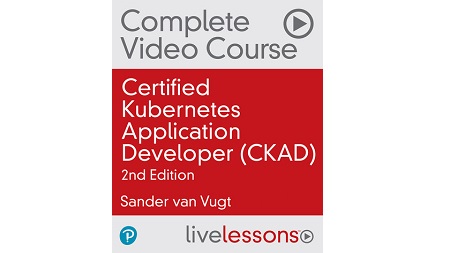
English | MP4 | AVC 1280×720 | AAC 44KHz 2ch | 156 Lessons (13h 22m) | 3.22 GB
Certified Kubernetes Application Developer (CKAD) Complete Video Course, 2nd Edition (Video Training) provides video instruction for IT professionals–including IT Administrators, DevOps Engineers, Software Developers, IT Architects, and Hybrid Cloud Administrators–preparing to take the CKAD exam, which requires an in-depth knowledge of how to develop, create, manage, store, and troubleshoot Kubernetes applications.
The course includes labs, demonstrations, and lightboard explanations by best-selling author and presenter Sander van Vugt. This course first provides a full introduction to containers and Kubernetes; it then moves through the process of creating, managing, and storing applications. The title provides labs for working with the API using curl, as well as using NameSpace and managing pods. You will also learn how to manage deployments, services, ingress, and setting up storage; and you will get a full walkthrough of key troubleshooting scenarios. The course ends with a sample exam so you can practice before taking the real test.
- Module 1: Container Fundamentals
- Module 2: Kubernetes Essentials
- Module 3: Building and Exposing Scalable Applications
- Module 4: Advanced Kubernetes
- Module 5: Certified Kubernetes Practice Exam
Table of Contents
1 Certified Kubernetes Application Developer (CKAD) – Introduction
2 Module introduction
3 Learning objectives
4 What is a Container
5 Understanding Registries
6 Starting Containers
7 Managing Containers
8 Managing Container Images
9 Understanding Container Logging
10 Lesson 1 Lab – Using Containers
11 Lesson 1 Lab Solution – Using Containers
12 Learning objectives
13 Understanding Image Architecture
14 Tagging Container Images
15 Understanding Image Creation Options
16 Using Dockerfile to Build Custom Images
17 Creating Images with docker commit
18 Lesson 2 Lab – Creating Custom Container Images
19 Lesson 2 Lab Solution – Creating Custom Container Images
20 Learning objectives
21 Understanding Kubernetes Core Functions
22 Understanding Kubernetes Origins
23 Using Kubernetes in Google Cloud
24 Understanding Kubernetes Management Interfaces
25 Understanding Kubernetes Architecture
26 Exploring Essential API Resources
27 Lesson 3 Lab – Exploring Kubernetes API Resources
28 Lesson 3 Lab Solution – Exploring Kubernetes API Resources
29 Learning objectives
30 Understanding Kubernetes Deployment Options
31 Understanding Minikube
32 Installing Minikube on Ubuntu
33 Installing Minikube on Windows
34 Installing Minikube on macOS
35 Verifying Minikube is Working
36 Running Your First Application
37 Lesson 4 Lab – Setting up a Lab Environment
38 Lesson 4 Lab Solution – Setting up a Lab Environment
39 Module introduction
40 Learning objectives
41 Understanding Pods
42 Understanding YAML
43 Generating YAML Files
44 Understanding and Configuring Multi-Container Pods
45 Managing Init Containers
46 Using NameSpaces
47 Lesson 5 Lab – Managing Pods
48 Lesson 5 Lab Solution – Managing Pods
49 Learning objectives
50 Exploring Pod State with kubectl describe
51 Using Pod Logs for Application Troubleshooting
52 Using Port Forwarding to Access Pods
53 Understanding and Configuring SecurityContext
54 Managing Jobs
55 Managing Cron Jobs
56 Managing Resource Limitations and Quota
57 Cleaning up Resources
58 Lesson 6 Lab – Managing Pod Advanced Features
59 Lesson 6 Lab Solution – Managing Pod Advanced Features
60 Module introduction
61 Learning objectives
62 Understanding Deployments
63 Managing Deployment Scalability
64 Understanding Deployment Updates
65 Understanding Labels, Selectors, and Annotations
66 Managing Update Strategy
67 Managing Deployment History
68 Understanding Deployment Alternatives
69 Bonus Topic – Understanding AutoScaling
70 Lesson 7 Lab – Managing Deployments
71 Lesson 7 Lab Solution – Managing Deployments
72 Learning objectives
73 Understanding Kubernetes Networking
74 Understanding Services
75 Creating Services
76 Using Service Resources in Microservices
77 Understanding Services and DNS
78 Lesson 8 Lab – Managing Services
79 Lesson 8 Lab Solution – Managing Services
80 Learning objectives
81 Understanding Ingress
82 Configuring the Minikube Ingress Controller
83 Using Ingress
84 Configuring Ingress Rules
85 Understanding IngressClass
86 Understanding and Configuring Network Policies
87 Lesson 9 Lab – Using Ingress
88 Lesson 9 Lab Solution – Using Ingress
89 Learning objectives
90 Understanding Kubernetes Storage Options
91 Configuring Volume Storage
92 Configuring PV Storage
93 Configuring PVCs
94 Configuring Pod Storage with PV and PVC
95 Understanding StorageClass
96 Lesson 10 Lab – Setting up Storage
97 Lesson 10 Lab Solution – Setting up Storage
98 Learning objectives
99 Providing Variables to Kubernetes Applications
100 Understanding Why Decoupling is Important
101 Providing Variables with ConfigMaps
102 Providing Configuration Files with ConfigMaps
103 Understanding Secrets
104 Understanding How Kubernetes Uses Secrets
105 Configuring Applications to Use Secrets
106 Configuring the Docker Registry Access Secret
107 Lesson 11 Lab – Using ConfigMaps and Secrets
108 Lesson 11 Lab Solution – Using ConfigMaps and Secrets
109 Module introduction
110 Learning objectives
111 Understanding the Kubernetes API
112 Using curl to work with API Resources
113 Understanding API Deprecations
114 Understanding Authentication and Authorization
115 Understanding API Access and Service Accounts
116 Configuring a ServiceAccount
117 Lesson 12 Lab – Configuring a ServiceAccount
118 Lesson 12 Lab Solution – Configuring a ServiceAccount
119 Learning objectives
120 Using the Helm Package Manager
121 Working with Helm Charts
122 Using Kustomize
123 Implementing Blue Green Deployments
124 Implement Canary Deployments
125 Understanding Custom Resource Definitions
126 Using Operators
127 Using StatefulSets
128 Lesson 13 Lab – Deploying Kubernetes Applications the DevOps Way
129 Lesson 13 Lab Solution – Deploying Kubernetes Applications the DevOps Way
130 Learning objectives
131 Determining a Troubleshooting Strategy
132 Analyzing Failing Applications
133 Analyzing Pod Access Problems
134 Monitoring Cluster Event Logs
135 Troubleshooting Authentication Problems
136 Using Probes
137 Lesson 14 Lab – Troubleshooting Kubernetes
138 Lesson 14 Lab Solution – Troubleshooting Kubernetes
139 Module introduction
140 Learning objectives
141 Exam Tips
142 Exam Question Overview
143 Working with NameSpaces
144 Finding Pods
145 Using ConfigMaps
146 Using Sidecars
147 Inspecting Containers
148 Using Probes
149 Creating a Deployment
150 Exposing Applications
151 Using Network Policies
152 Using Storage
153 Using Helm
154 Using Quota
155 Using ServiceAccount
156 Certified Kubernetes Application Developer (CKAD) – Summary
Resolve the captcha to access the links!